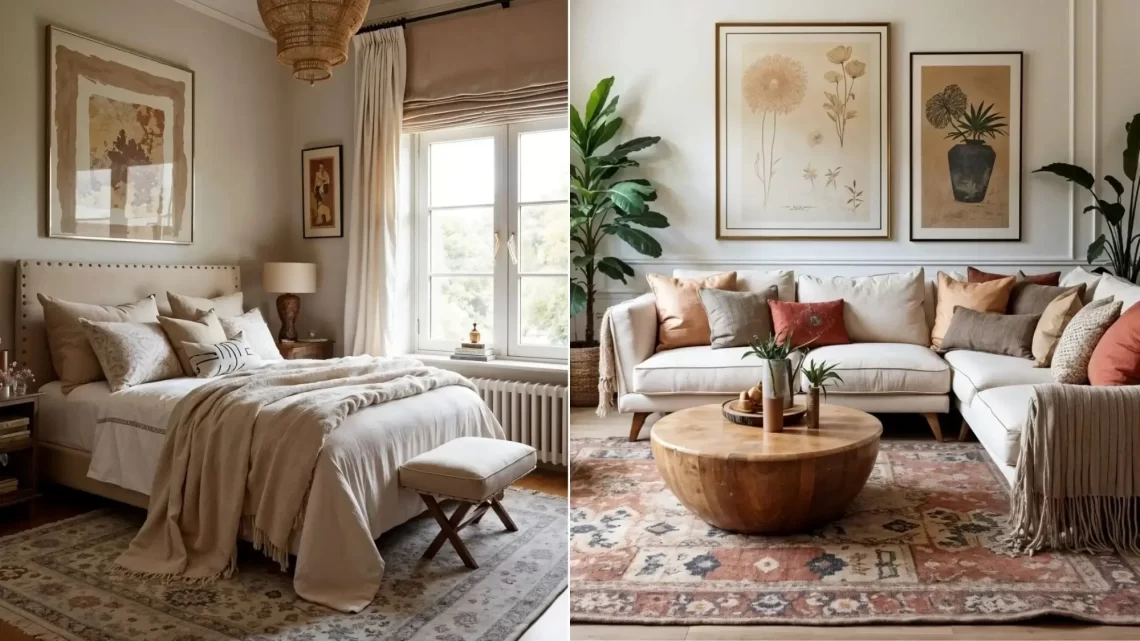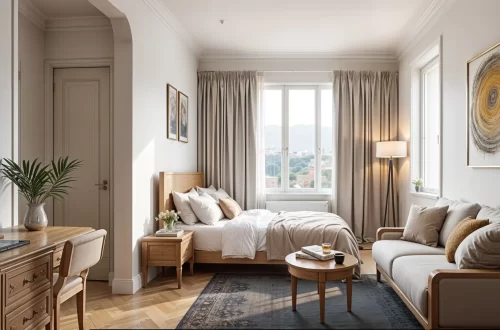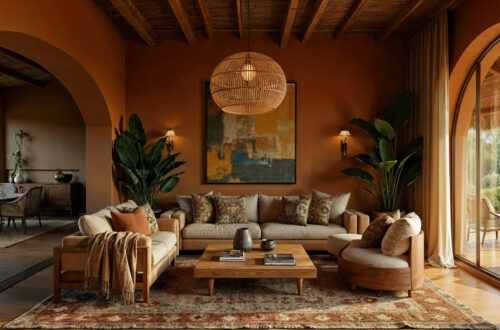Boho chic interior design walks an interesting line. It keeps the laid-back, free-spirited charm we love about bohemian style, but adds a layer of polish that makes the whole thing feel intentional. It’s elevated, and even a little fancy.
The thing with bohemian design is that it leans toward the casual. Natural materials, woven textures, plants everywhere, throws tossed with abandon. All of that warmth and comfort doesn’t always translate to “chic” on its own. But with a few added twists, it can.
Below, I’m walking you through five distinct approaches to boho chic interior design. Each one elevates bohemian style in its own way, and all of them work beautifully.
Jump to:
- Understanding Boho Style: The Foundation
- 1. Boho Chic Interior Design with Understated Elegance
- 2. The Abundant Approach to Boho Chic
- 3. Boho Meets Eclectic Modern
- 4. Color-Drenched Boho Chic Interior Design
- 5. Moody Boho Chic (My Personal Favorite)
Understanding Boho Style: The Foundation
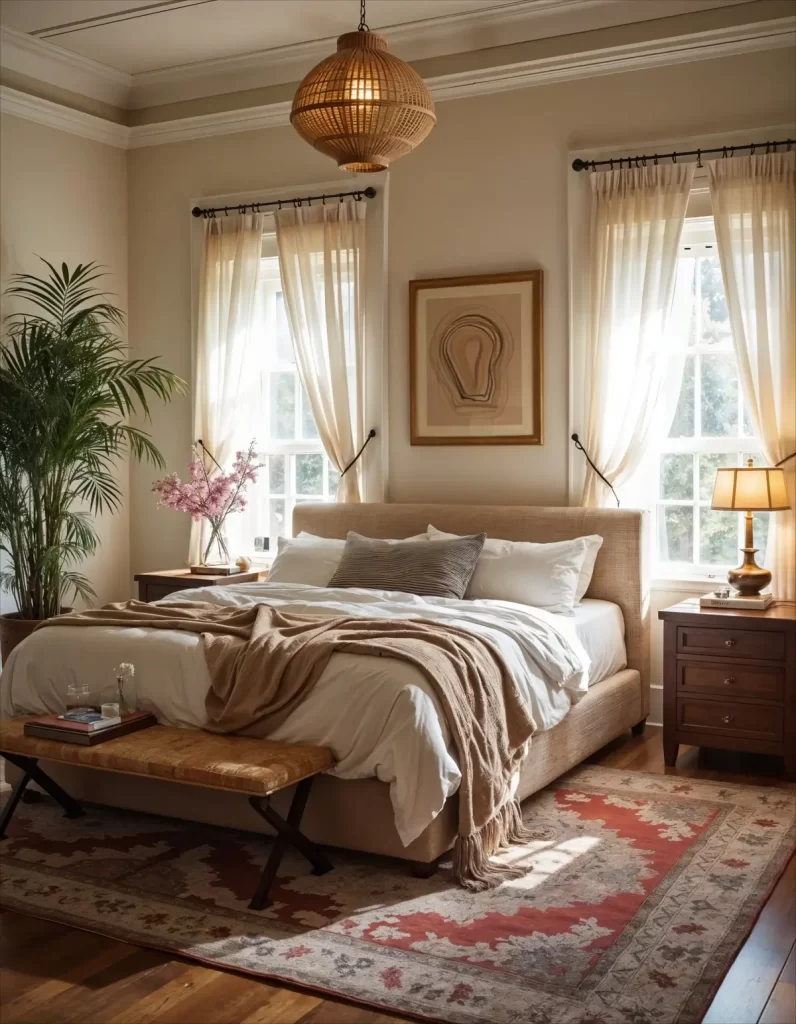
Before we dive into making bohemian design chic, let’s establish what we’re working with here.
Bohemian style is fundamentally about creating spaces that feel collected over time. Cozy, welcoming, slightly rustic. The opposite of clean-cut modern minimalism. It embraces natural materials like wood and rattan, features woven elements from baskets to lampshades, and welcomes plants with open arms.
The color palette skews earthy—soft beiges, warm terracottas, muted greens. Patterns appear through textiles and rugs, often with global influences. Everything feels relaxed and lived-in rather than staged.
I’ve covered the foundations extensively in my guides to Afro-Bohemian bedroom decor and bohemian interior decorating, so I won’t repeat every detail here. But understanding these core principles matters because boho chic interior design builds directly on them.
The Elements That Define Bohemian Style
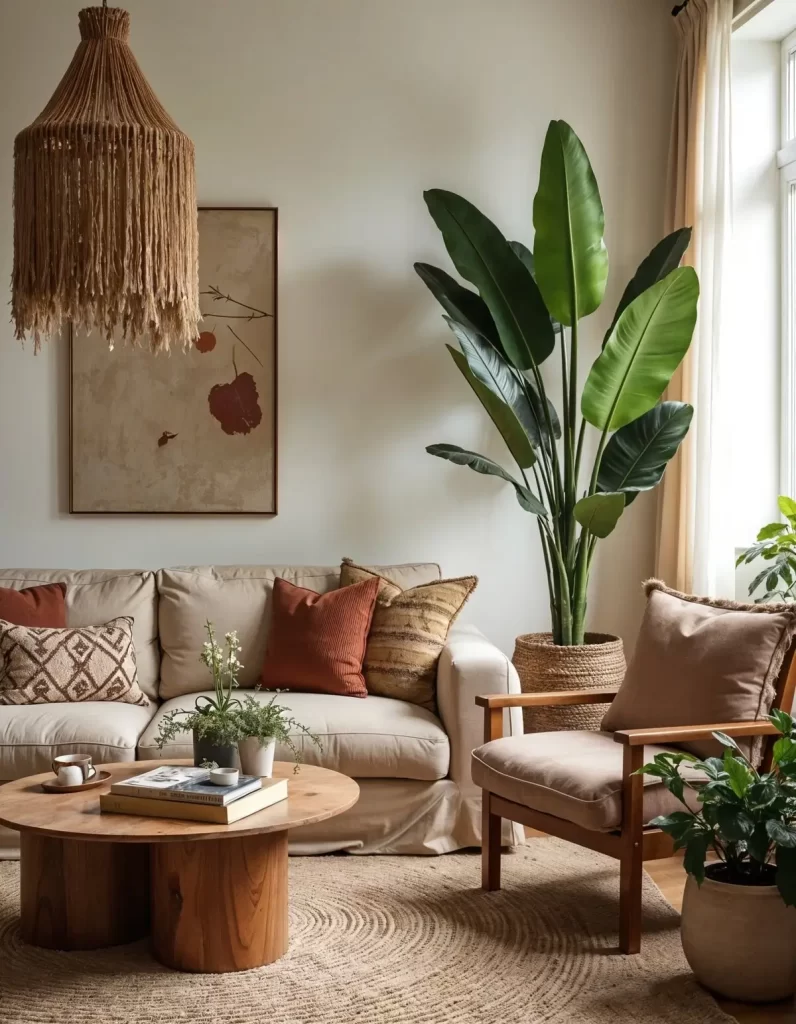
Here’s what typically shows up in bohemian spaces:
- Natural materials: Wooden furniture, woven baskets, jute rugs, clay pottery. These add warmth and texture.
- Layered textiles: Throw pillows, blankets, rugs stacked on rugs. Comfort is priority number one.
- Plants as decor: Monstera, fiddle-leaf figs, pothos trailing from shelves. The more greenery, the better.
- Earthy color schemes: Think sand, terracotta, warm browns, soft greens. Colors you’d find walking through nature.
- Woven lighting: Pendant lamps made from rattan or raffia. They cast beautiful shadows and add instant character.
- Relaxed vibe above all: Floor cushions, poufs, seating that invites you to sink in and stay awhile.
This foundation is nice, but it reads casual by nature. So how do we make boho chic?
1. Boho Chic Interior Design with Understated Elegance

This is your most accessible entry point. Simple, refined, and sophisticated.
The approach here involves editing. You keep bohemian’s essence but apply minimalist principles to the execution. Fewer items, better quality, nothing excessive.
How to Achieve Understated Boho Chic
Start with a neutral base. Soft beiges, creamy whites, gentle taupes for your walls and larger furniture pieces. This creates a calm foundation.
Choose natural materials deliberately. A cotton throw in soft ivory. A wool rug in warm sand tones. These classic, chic materials effortlessly elevate the space.
Add woven elements sparingly. One elegant pendant lamp above your bed. Maybe a handwoven basket holding throws. Just enough to signal bohemian without overdoing the texture.
Keep plants minimal. Two or three well-placed greenery arrangements rather than a curated jungle. Each plant becomes more intentional.
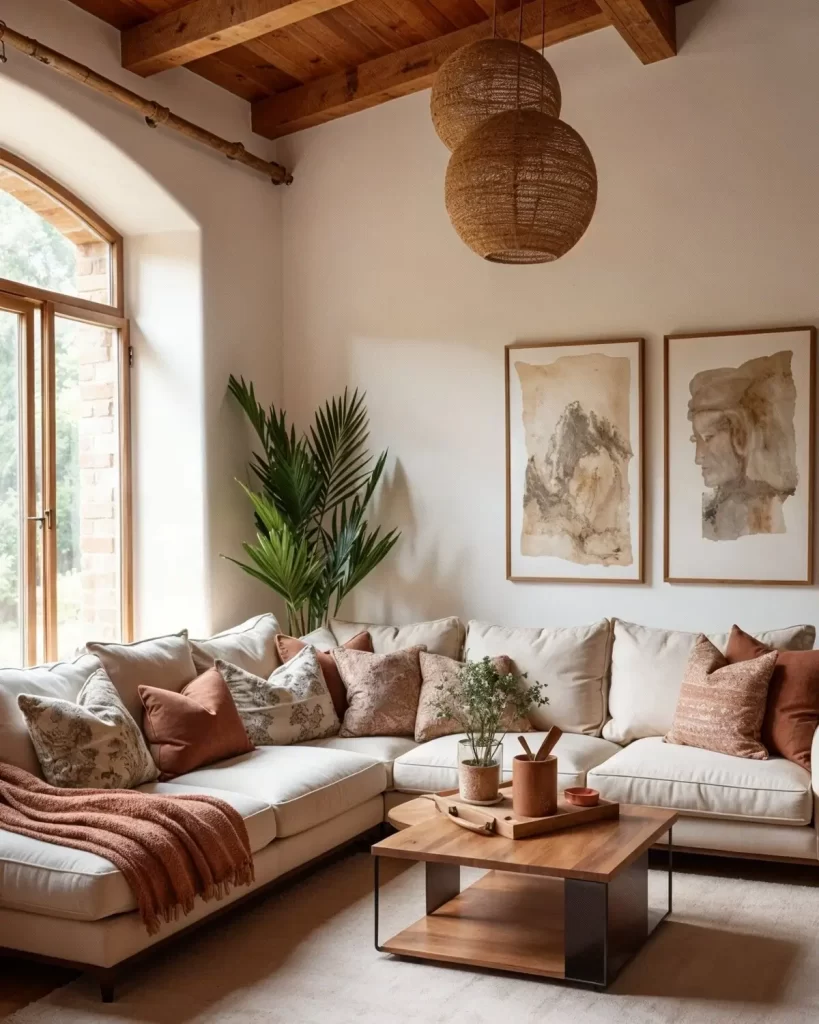
The Color Story for Understated Elegance
This version of boho chic interior design loves soft, muted colors:
- Base neutrals: Cream, beige, soft taupe
- Accent tones: Dusty pink, muted sage green, warm terracotta used lightly
- Wood tones: Light to medium browns that feel organic
Patterns appear through subtle florals or very simple geometric designs. Nothing bold. Nothing that dominates. The whole vibe reads “collected with care” rather than “accumulated over time.”
Our top pick: this rust brown wool rug
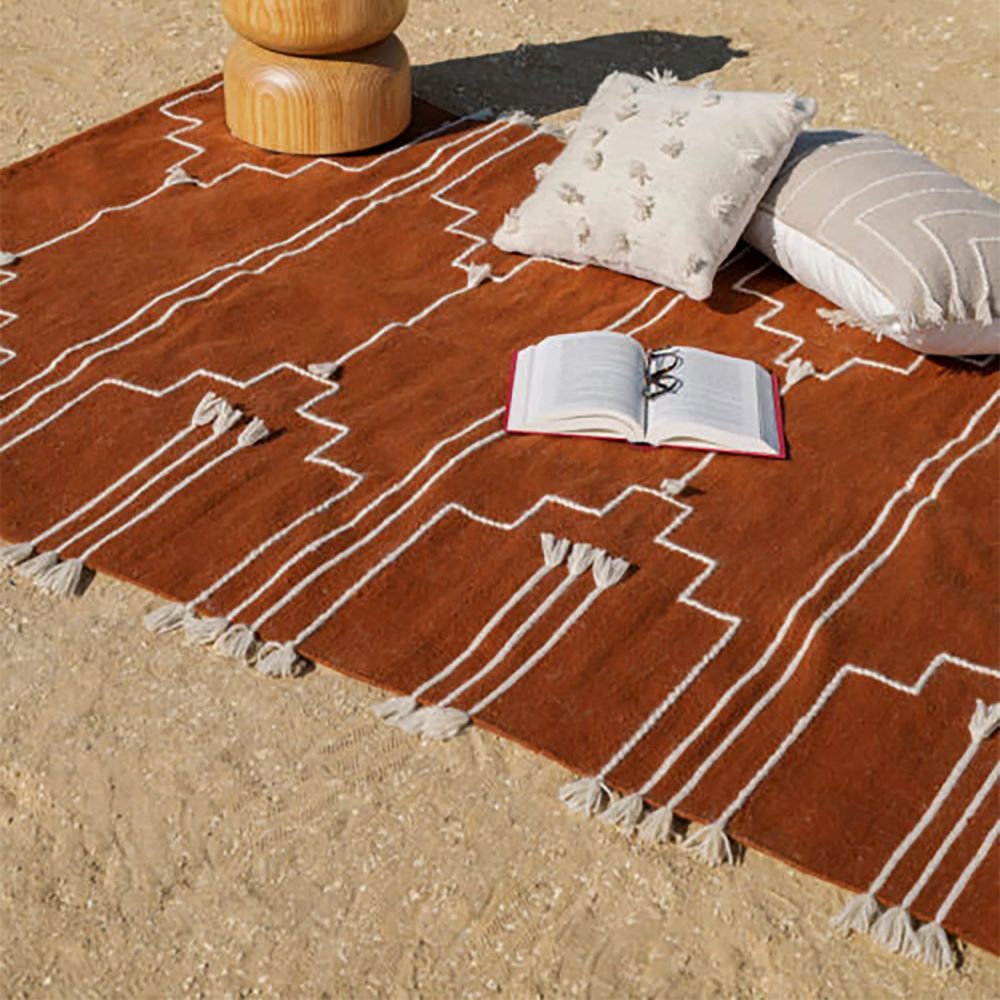
Handwoven in Egypt using traditional kilim techniques, its color and material are perfect for the boho chic look.
What Makes This Approach Chic
The restraint. In typical bohemian design, more is usually more. Here, less becomes genuinely elegant. You’re curating rather than collecting.
This works great in bedrooms where you want calm sophistication, or living rooms that need to feel polished for guests but still inviting enough for everyday lounging.
2. The Abundant Approach to Boho Chic
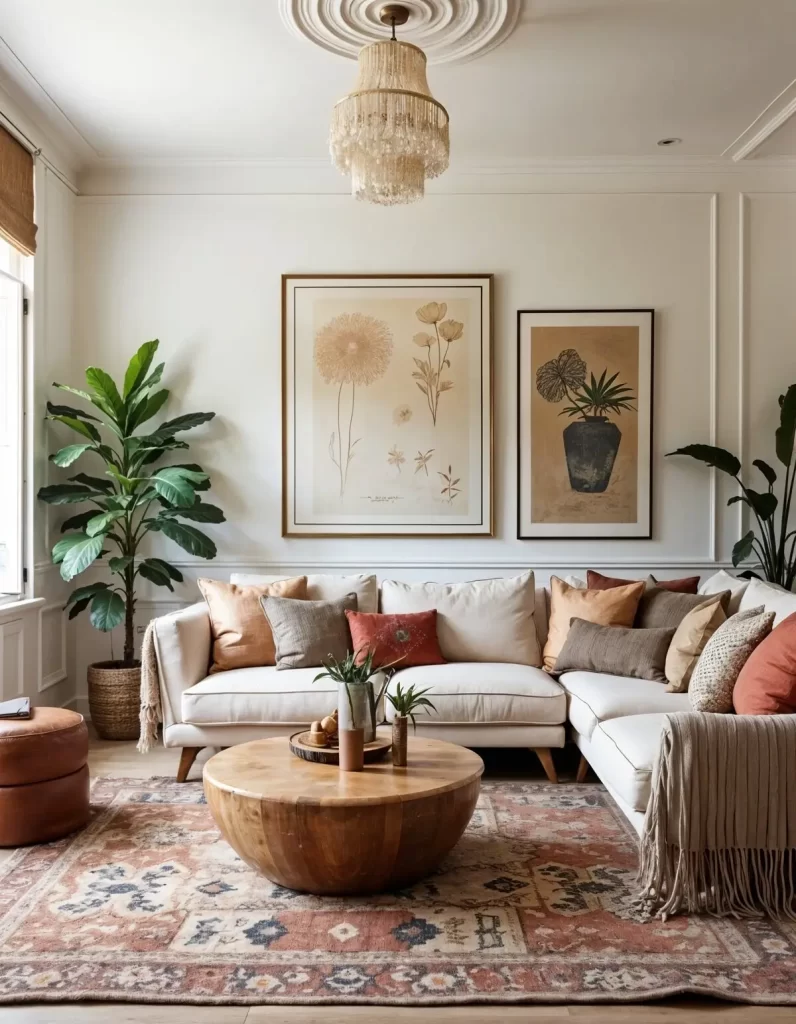
Now we’re going a different direction. This style embraces abundance but makes it luxurious.
Think plush, layered, visually rich. It’s about creating that “sink into comfort” feeling while maintaining a chic, curated aesthetic. The abundance itself becomes the luxury.
Creating Luxurious Abundance
Start with your textiles. This approach demands throw pillows—lots of them. Eight to twelve on a large sofa isn’t excessive here. But they should be high-quality materials in coordinated colors.
Layer your throws too. On your bed, you could go up to three. Cashmere blends, chunky knits, soft cotton weaves. The variety in texture creates visual interest but keep them in similar tones for that chic look.
Also, don’t hesitate to layer window treatments: sheer curtains and solid ones, or roman shades with floor-to-ceiling curtains.
For the rug, we’re going ornate. Beautiful oriental patterns that dress up the room and pair well with the abundant feel.

What to Minimize for Chic Results
Here’s the trick: plants don’t help this particular agenda. Too much greenery shifts the vibe from luxurious to cluttered. Keep plants minimal or skip them entirely in favor of those gorgeous textile layers.
The color palette stays relatively contained. Choose three to four coordinating colors and work variations of those throughout your throws and pillows. This creates harmony within the abundance.
Our top pick: this cream lumbar pillow

Handwoven from soft cotton, it’s the perfect finishing touch to your pillow arrangement.
Making Abundance Feel Intentional
The line between “luxuriously abundant” and “messy chaos” comes down to coordination. Your throws and pillows should clearly relate to each other through color, texture, or pattern.
This version of boho chic interior design works brilliantly in more formal living rooms, or bedrooms where you want to create that hotel-luxury feeling while keeping bohemian warmth.
3. Boho Meets Eclectic Modern

This is where things get interesting. You’re deliberately creating contrast between bohemian elements and clean, modern design.
The eclectic approach thrives on that tension. Vintage meets contemporary. Soft meets angular. Neutral meets bold. It requires confidence but delivers serious personality.
The Foundation of Eclectic Boho Chic Interior Design
Start with modern furniture that has clean lines. A sleek coffee table in simple geometric shapes. A contemporary sofa with crisp silhouette. These anchor your space with structure.
Then introduce bohemian elements that contrast sharply. A plush wool rug beneath that modern coffee table. The vintage chair you thrifted in a market. The juxtaposition creates visual interest.
Add one or two statement pieces in strong accent colors. Bonus for patterns. Upholstered chairs or ottomans and throw pillows work great for this. They become focal points that give the space energy.
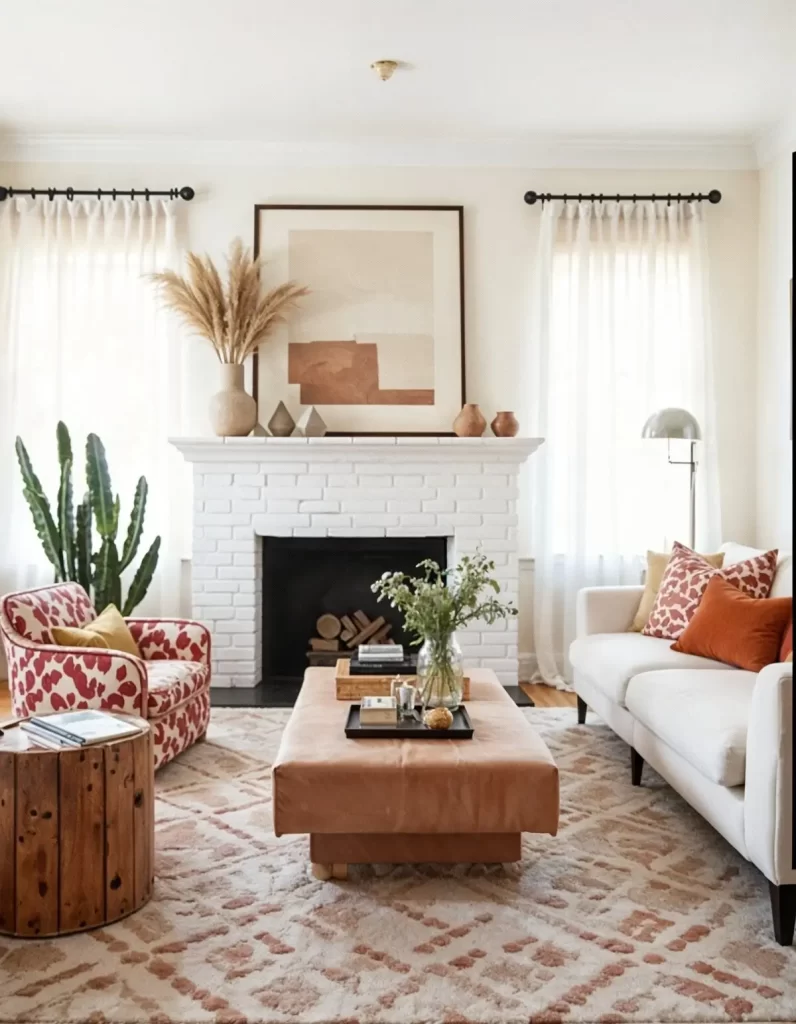
Color Strategy for Eclectic Modern Boho
Your base stays relatively neutral—those earthy beiges and soft taupes that define bohemian style. But you punctuate with stronger colors:
- Earthy foundation: Beige, sand, warm brown
- Strong accents: Deep red, rich terracotta, forest green
The key is contrast. You want those bold colors to really stand out against your softer base, and the vintage elements to be highlighted by the modern furniture. That style thrives on curated statement pieces.
Our top pick: this fun palm tree throw pillow

A vibrant pillow that adds personality and color to your space.
Getting the Balance Right
Don’t crowd your statement furniture with competing elements. Every bold piece needs space around it to make its impact.
Modern pieces should have clean, simple forms. The boho elements bring pattern and texture. This division of responsibilities keeps everything from fighting for attention.
This approach to boho chic interior design works beautifully for those who want spaces with serious personality. It’s collected and full of stories. Bold but balanced. The contrast itself becomes the style.
4. Color-Drenched Boho Chic Interior Design

Color-drenching has taken over design lately, and for good reason. It’s dramatic and absolutely transforms spaces. Applied to bohemian design? Even better.
This approach involves painting walls, ceiling, and sometimes even trim in the same or similar colors.
How to Color-Drench a Boho Space
Choose your color deliberately. This style works beautifully with warm tones that complement bohemian’s earthy palette:
- Light terracotta for warmth
- Sage green for subtle drama
- Warm beige for understated elegance
Paint the walls and ceiling in your chosen color or close variations. It creates an enveloping, immersive atmosphere.

Taking It Further with Texture
Color-drenching alone elevates your space. But adding textured wall treatments takes it into truly chic territory.
Consider Roman clay finishes or limewash paint. These create depth that flat paint simply cannot. The slight variations in tone as light moves across the walls add genuine sophistication.
Or try textured wallpaper in your chosen color. Grasscloth works beautifully with bohemian style. It adds dimension while maintaining that natural, organic feeling.
Lighting as the Finishing Touch
Here’s where you really cement the chic factor: upgraded lighting fixtures.
Forget basic lamps and simple pendants. This style demands lighting with presence. Contemporary chandeliers in living rooms. Elegant pendant lights flanking your bed. Sculptural floor lamps that become art pieces themselves.
In color-drenched rooms, lighting creates drama. Modern brass or matte black fixtures work gorgeously against warm color-drenched walls. They provide contrast and add to the designed feel.
Our top pick: a striking multi-light pendant
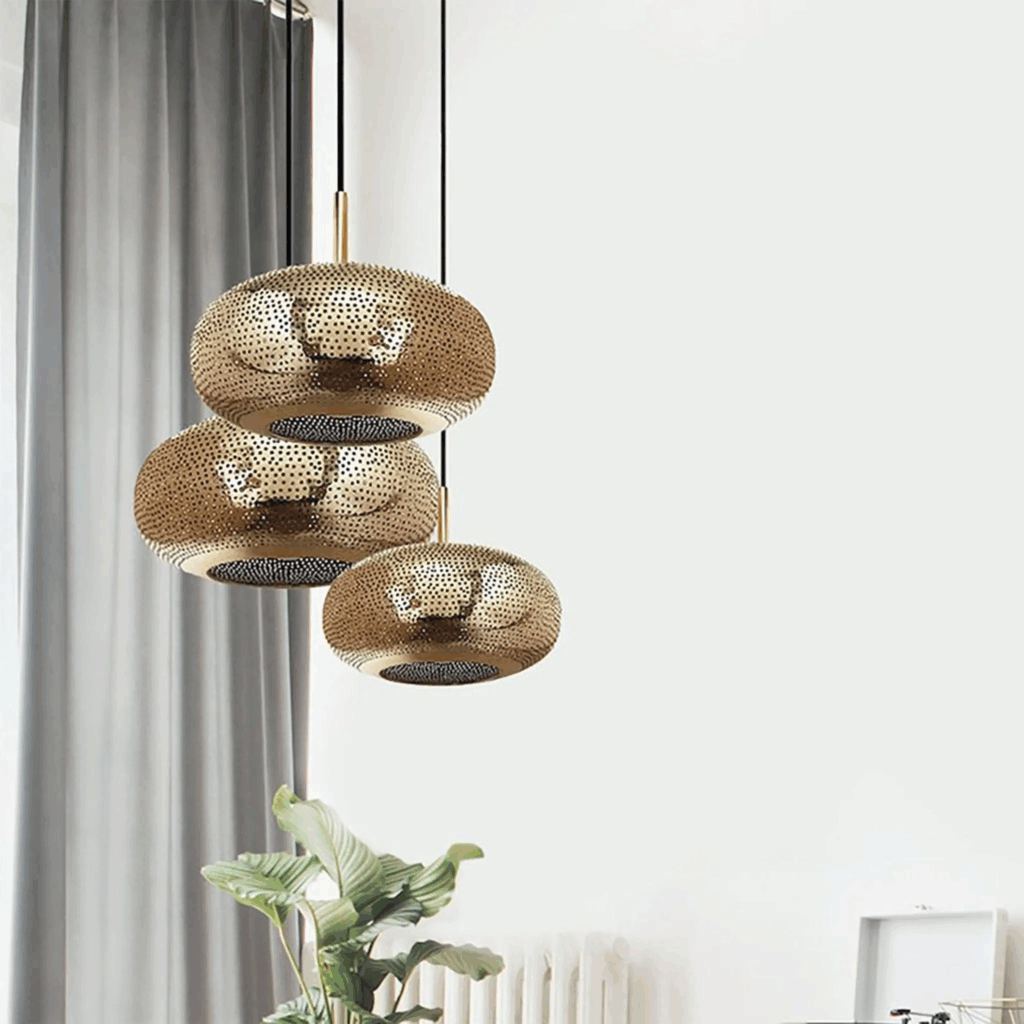
A brass chandelier handcrafted my master artisans in Morocco, guaranteed to ignite the space.
5. Moody Boho Chic (My Personal Favorite)
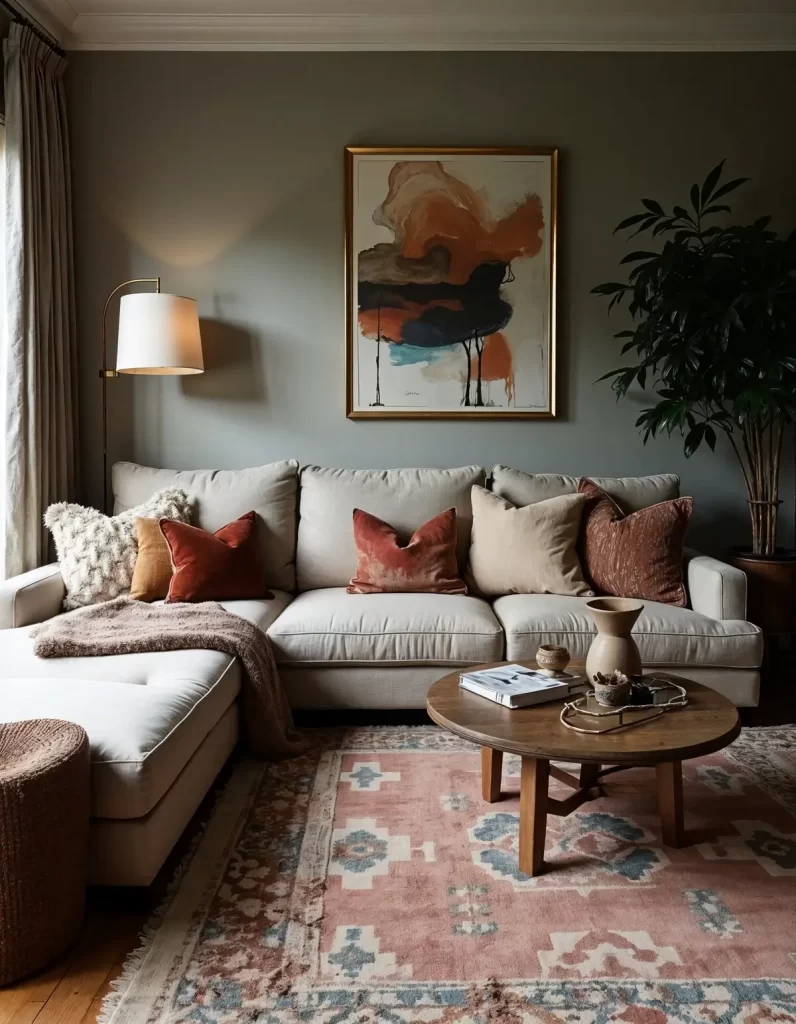
This approach might be controversial, but I absolutely love it. We’re taking bohemian style and making it dark, dramatic, and utterly sophisticated.
Traditional boho tends toward light, airy, sun-drenched spaces. This goes completely opposite. And somehow it feels more refined because of it.
Creating the Moody Foundation
You need a dark accent wall. Deep navy, forest green, even burgundy. Choose whichever dark tone speaks to you and commit to it on at least one wall.
That single dark surface instantly transforms your room’s entire atmosphere. It grounds everything and makes lighter elements pop in contrast.
If you want to go further, paint multiple walls in your dark color. Or even the entire room.
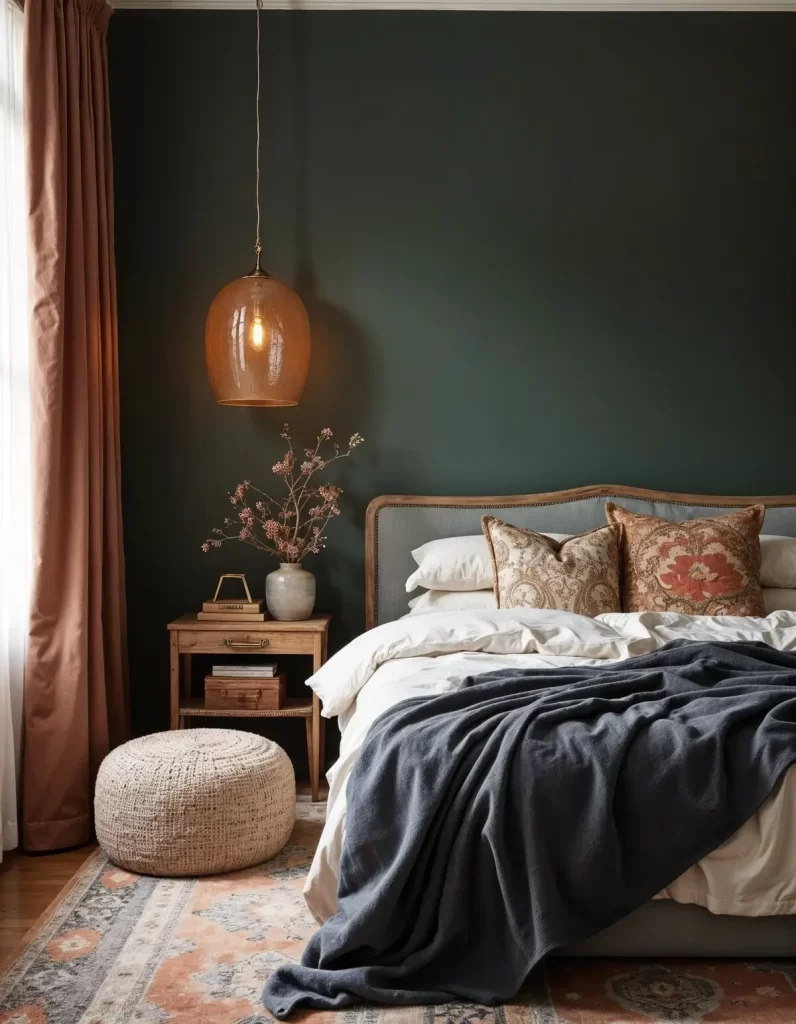
Bringing in Darker Bohemian Elements
To continue on the moody feel, opt for some deeper, darker accents instead of those light, earthy tones.
- Deep terracotta instead of soft peachy tones
- Forest green instead of sage
- Deep ochre instead of light tan
- Charcoal gray instead of cream
These colors work beautifully in throws, pillows, and rugs.
Our top pick: this dark green cotton rug
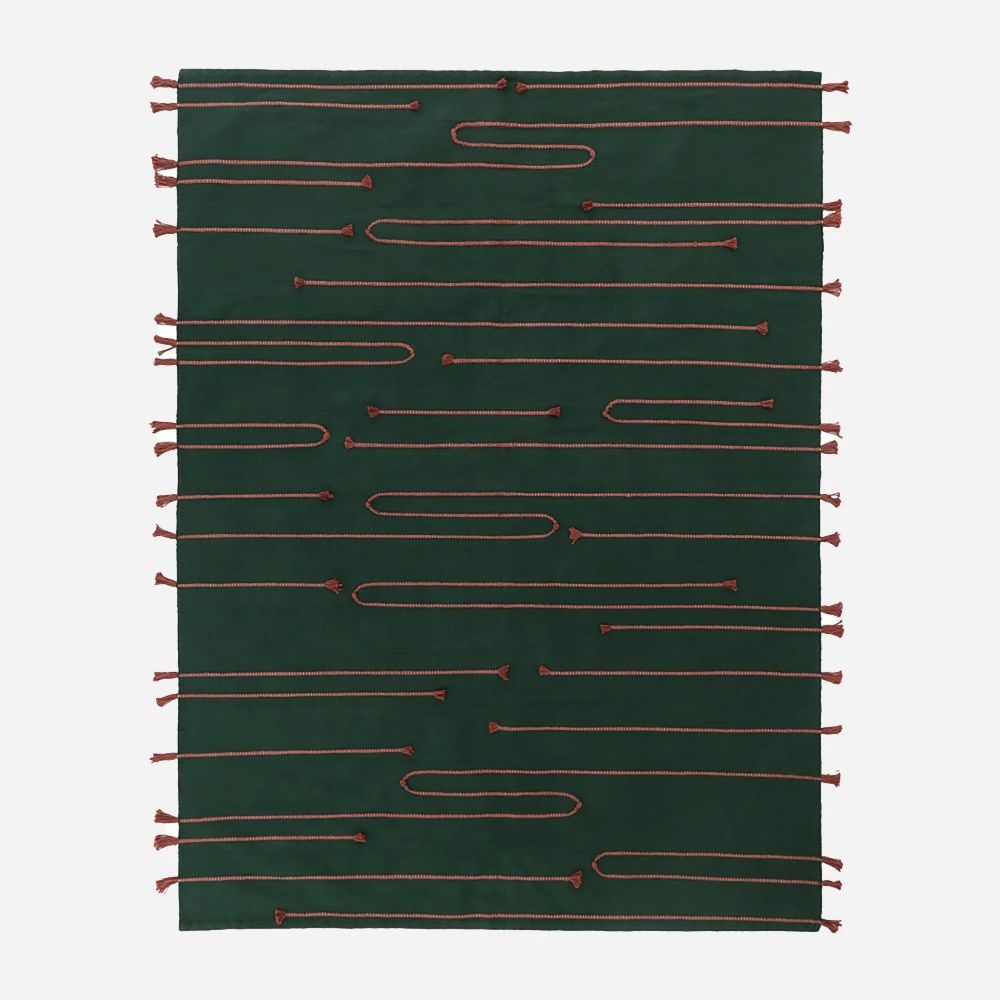
Just the right amount of moody for a boho space with a twist.
Why This Works So Well
The moody approach takes boho chic interior design in an unexpected direction. It maintains all those core bohemian elements—natural materials, woven textures, comfortable layers. But the darker palette transforms everything.
Suddenly your space feels sophisticated. Even a bit mysterious. It almost doesn’t read as bohemian at first glance, but all the foundations are there. Just amplified and refined.
This works beautifully in bedrooms where you want a cozy, intimate atmosphere. Or living rooms where you’re ready to make a statement.
I genuinely love this style because it challenges what we think bohemian design should be. It proves that boho can be moody and chic simultaneously. Rich and sophisticated while staying true to its relaxed, collected roots.
Making Boho Chic Interior Design Work for You
The five approaches we reviewed today are flexible. You can adopt one style completely or blend elements from several.
Want understated elegance? Go minimal with quality pieces. Love abundance? Layer those gorgeous textiles. Ready for drama? Try color-drenching or the moody approach.
Whatever you choose, remember that boho chic interior design maintains bohemian’s core warmth. These styles elevate without abandoning comfort. They add sophistication but keep the lived-in feeling.
The goal isn’t perfection. It’s creating spaces that feel both elevated and genuinely fits your personality. Chic but comfortable. Sophisticated but not stuffy. That’s what boho chic interior design delivers when you get it right.

